
Crossroads Independence
Explore the threads of the entrepreneurial and volunteer spirit, and cultural traits that have been engrained in Independence wealth, agriculture, and subcultures since it was an 1869 frontier settlement. How are these characteristics manifested through prominent community elements and how have they contributed to change? What does this tell us about where the community is going?
Exhibit by Ray Rothgeb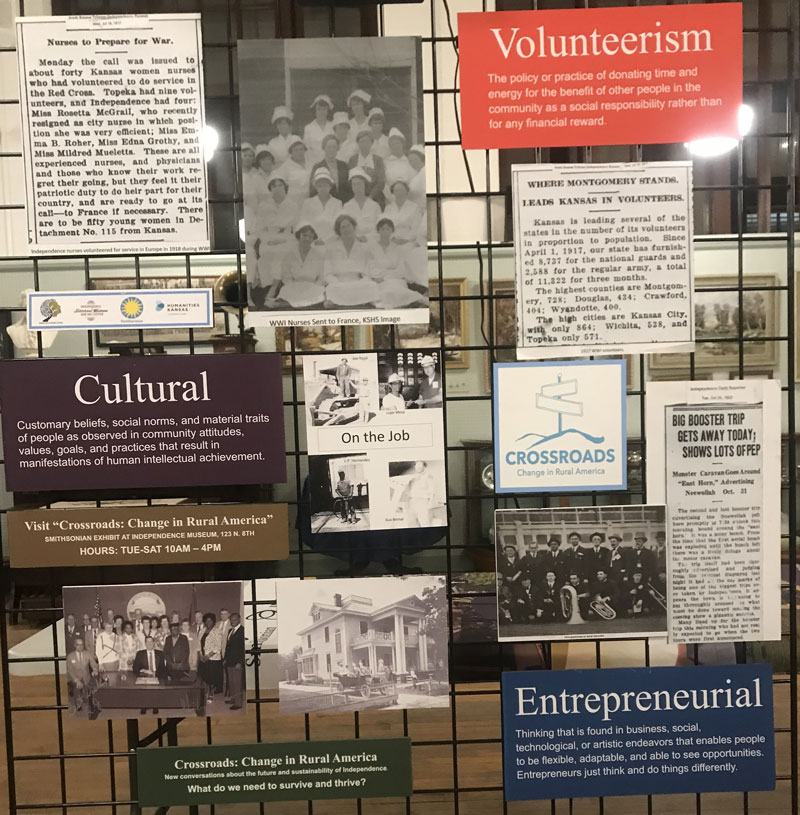

Crossroads Themes
Local Exhibit: The local exhibit explores threads of the entrepreneurial and volunteer spirit, and cultural traits that are engrained in Independence wealth, agriculture, and subcultures since its settlement in 1869. Each exhibit can be viewed from street-side of downtown businesses and asks the question, “What do we need to survive and thrive?”
Volunteerism: The policy or practice of donating time and energy for the benefit of other people in the community as a social responsibility rather than for any financial reward.
Cultural: Customary beliefs, social norms, and material traits of people as observed in community attitudes, values, goals, and practices that result in manifestations of human intellectual achievement.
Entrepreneurial: Thinking that is found in business, social, technological, or artistic endeavors that enables people to be flexible, adaptable, and able to see opportunities. Entrepreneurs just think and do things differently.
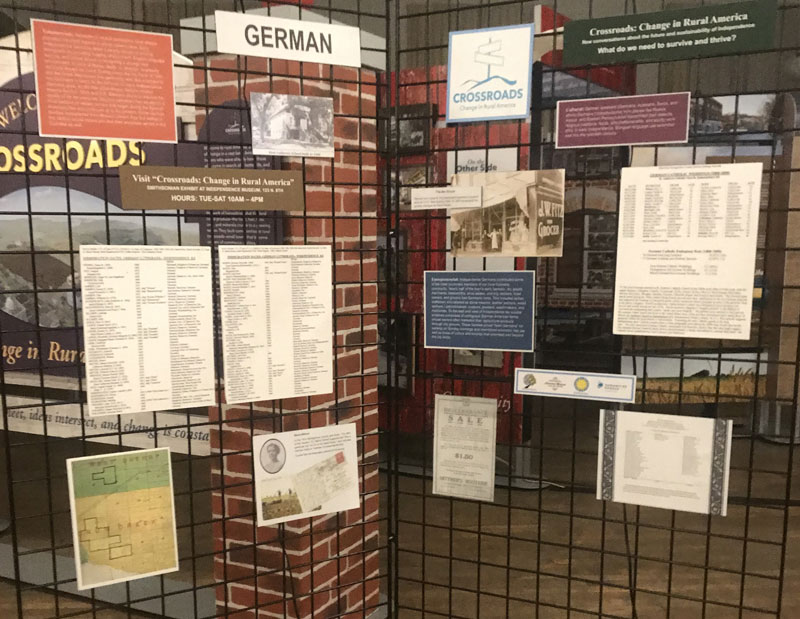

German
Volunteerism: Wealth generated a spirit of volunteerism and philanthropy. Many well-to-do citizens felt obligated to give back to the community through the many local charities. Support for the public library, parks, zoo, schools and other institutions was often led by a progressive affluent class. Wealthy residents vested considerable pride and identity in their town, and harbored huge ambitions for the future.
Cultural: German speakers transmitted their dialects, religious traditions, foods, arts/craftsmanship, and sturdy work ethic to early Independence. Bilingual language use extended well into the twentieth century.
Entrepreneurial: Independence Germans contributed some of the most prominent members of our local business community. Nearly half of the town’s early businesses had Germanic roots. Beyond the city were German American farms, whose owners often marketed their products through city grocers. These families maintained economic ties extending well beyond the city limits.
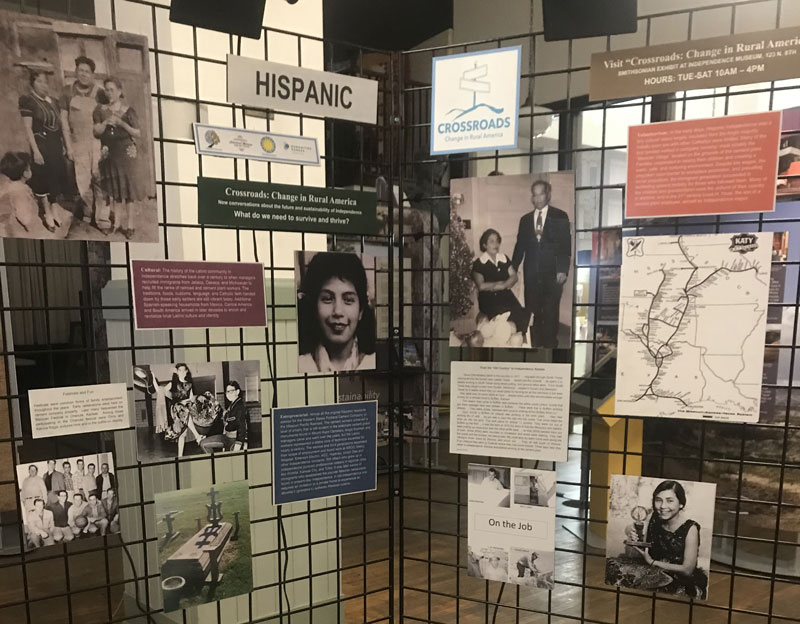

Hispanic
Volunteerism: Many families settled in company housing, most notably the “Mexican Village” on the grounds of the cement plant. Many of the children and grandchildren served their country in wartime.
Cultural: The Independence Latino community goes back to when managers recruited immigrants from Mexico to work on the railroad and at the cement plant. Traditions, language, and faith were handed down and are still vibrant today. Additional Hispanics arrived in later decades to enrich and revitalize local Latino culture and identity.
Entrepreneurial: Most original Hispanic residents worked for the cement plant or the railroad. Cement workers achieved a level of artistry that can be seen in the elaborate cement grave monuments found in the cemetery. The second and third generations expanded their scope of employment to major businesses and manufacturing companies and recent generations pursued professional careers.


African-American
Volunteerism: Many individuals defied segregation and discrimination by breaking through existing racial barriers in schools, workplaces, and public facilities. Dozens of African Americans served in the armed forces.
Cultural: The first African Americans reached Montgomery County while it was still part of the Osage Diminished Reserve. Settlers from southern states brought historic black church denominations, foods, traditions, and accents to the county. Most black voters joined the party of Lincoln, at times making them an important political block that progressive and rival mainline Republicans courted for support.
Entrepreneurial: Early black residents brought knowledge of cotton cultivation and built the first cotton gin. African Americans created numerous businesses of their own while others became respected professionals. By 1900 an area on Main Street became a center of black business development. In following years black-owned businesses were diffused across the city.
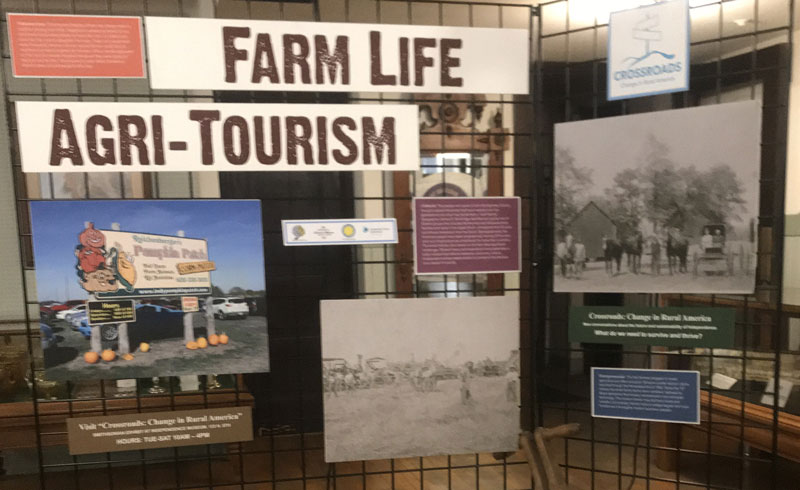

Agriculture
Volunteerism: Farm neighbors shared tools and equipment, worked as teams to harvest crops, and butcher meat. Helping others remains a central value of rural people to this day.
Cultural: The people who came to farm brought cultural influences that have merged over five generations into a “rural identity.” People have been progressively moving off the land for more than a century. Shared history and experience have generated a sober outlook that reflects resilience, autonomy, and an independent-minded determination to conserve core values of rural life.
Entrepreneurial: The first farmers engaged in mixed agriculture and often occupied 160-acre claims acquired through the Homestead Act of 1862. Since the 19th century small family farms have vanished, being replaced by larger operations that employ mechanization and computer technology. Many modern farmers hold college degrees and function as modern business operators.
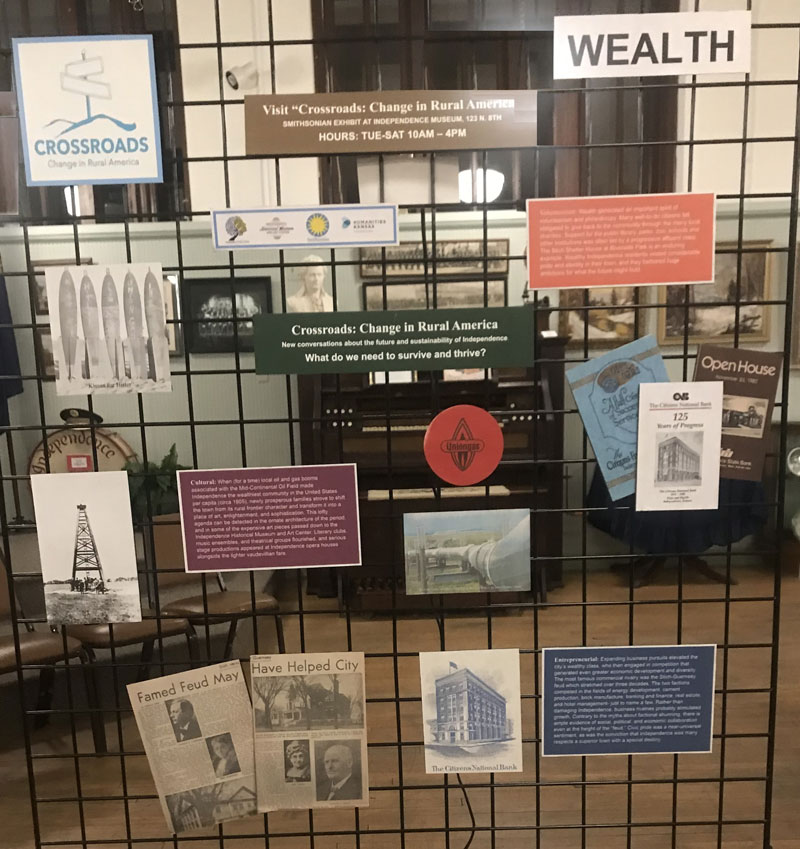

Wealth
Volunteerism: Early Independence Germans aided a steady stream of arriving immigrants. As the fortunes of many Independence Germans grew, so did their philanthropy. Staunch patriotism has resulted in a local tradition of military service that began during the Spanish American War and continues up to the present.
Cultural: Oil and gas made Independence the wealthiest community in the United States (circa 1905). Prosperous families strove to shift the town from its rural frontier character into a place of art, enlightenment, and sophistication. Literary clubs, music and theater groups flourished.
Entrepreneurial: Expanding businesses elevated the city’s wealthy class, who engaged in competition that generated even greater economic development and diversity. The most famous commercial rivalry was the Stich-Guernsey feud which stretched over three decades and resulted in many community amenities. Civic pride was a near-universal sentiment.
Crossroads Independence
The full exhibit is on display at Independence Historical Museum and Art Center123 N. 8th Street
Independence, Kansas 67301


 Get Directions
Get Directions Visit Website
Visit Website